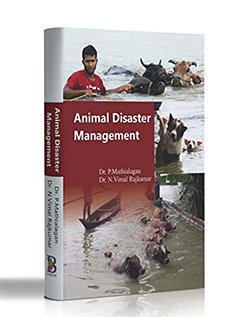 Authors
Authors
P. Mathialagan and N. Vimal Rajkumar
Reviewed by
Steve Glassey
Animal Evac New Zealand
Published by
Agri-biovet Press
ISBN: 978-93-84502-84-3
In the past couple of decades, the emerging field of animal disaster management has seen a greater number of journal articles and books on the subject. Initially, the bulk of the publications came out of the United States, often building on the experiences from Hurricane Harvey, which was the catalyst for reform and research. Now, we are seeing a more globalised range of publications and this is welcome progress. When I saw the new book, Animal Disaster Management by P. Mathialagan and N. Vimal Rajkumar, I was quick to order it online to see what new gems of knowledge could be gleaned.
What intrigued me most about the book was that I had never heard of the authors nor their works relating to animal disaster management and so I was looking forward to fresh perspectives and ideas to challenge my own thinking. A further cursory search found negligible research in the animal disaster management context, however the authors had solid research experience in veterinary sciences, particularly with livestock. The book starts by referring to ‘natural disasters’, which is a misnomer in contemporary emergency management. The book’s format and approach appeared to be an adaptation of a thesis than a book, but it is well organised and has a good flow from introducing basic terms through to more complex considerations.
The book title is not an accurate reflection of its content. A more suitable title to align reader expectations could be ‘Livestock disaster management in India’, which is a major contribution to the body of knowledge. The range of references is light in regard to animal disaster management, with the exception of Sebastian Heath’s works. It was surprising the works of Leslie Irvine, James Sawyer, Gerardo Huertas and Dick Green were not featured especially given the book’s focus on livestock disaster management in developing nations.
Despite these reflections, the book deserves to be read, especially by those within the veterinary and primary industries. What is well covered in this book that is not commonly published, is research on the indigenous disaster risk reduction practices for livestock around floods and earthquakes, many of which have relevance in developed countries too. The authors offer 3 animal disaster management models specific to drought, earthquakes and hydrological hazards (floods, cyclones, etc) that provide a simple visual aid for farmers and policy makers.
I feel unqualified to comment on the sections on veterinary care and restraint but suggest they would be of benefit to veterinary practitioners and emergency responders.
For those seeking to diversity their knowledge in practical ways to implement livestock-focused disaster risk reduction in developing countries that are similar to India, this book provides a depth of information that helps build livestock-inclusive community resilience.


